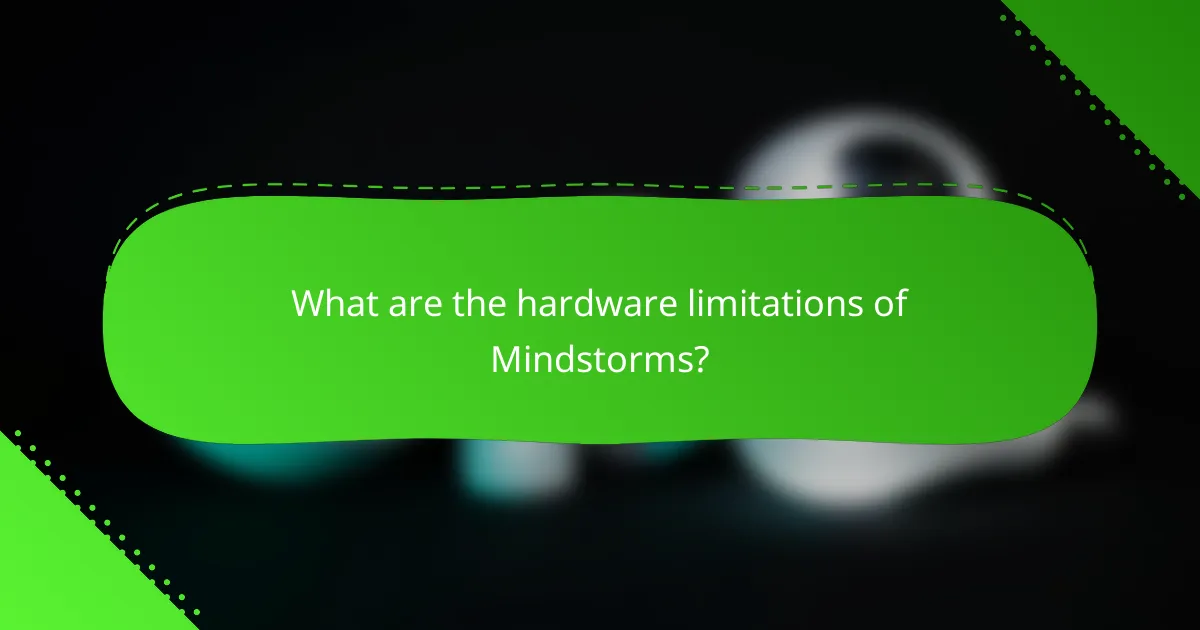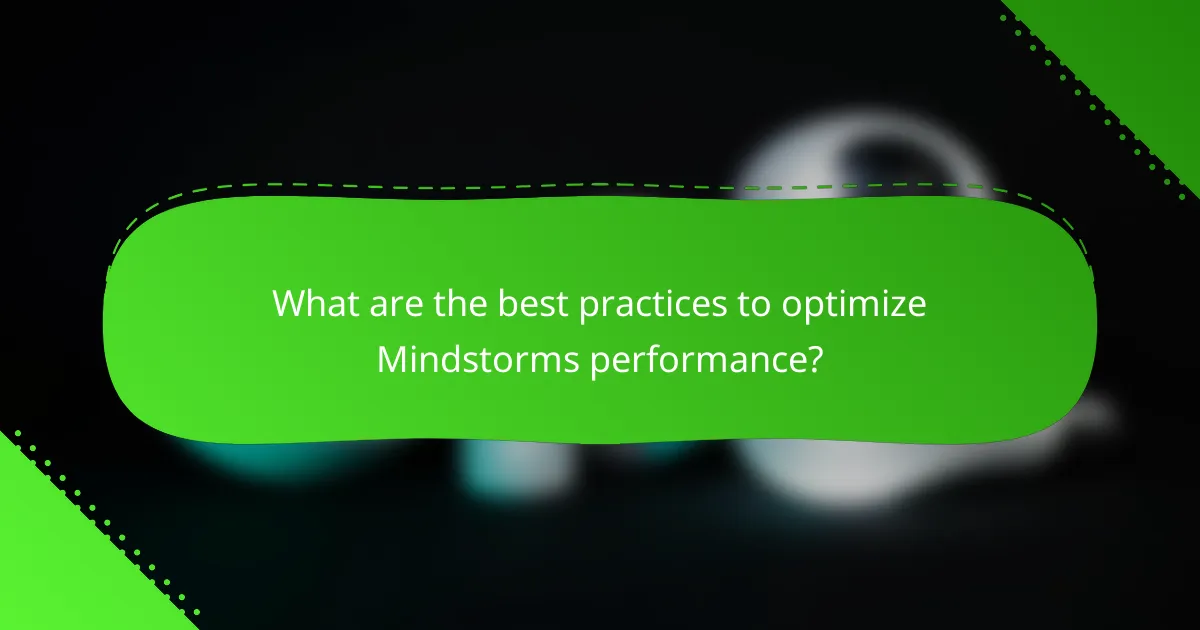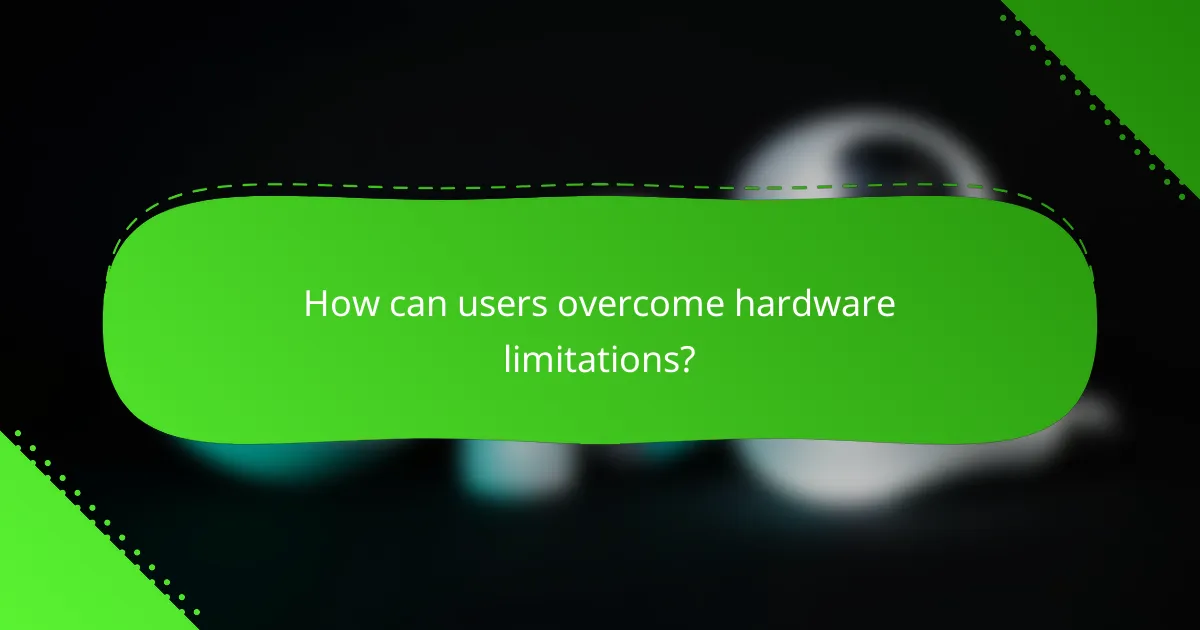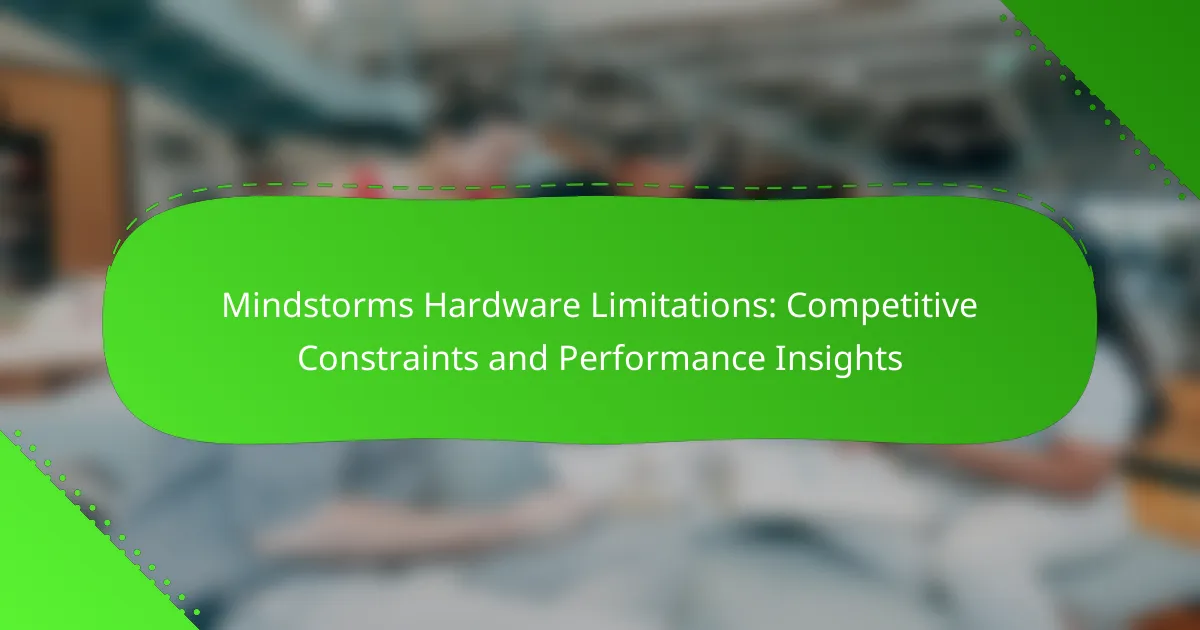The hardware limitations of Mindstorms, including processing power, sensor compatibility, and battery life, play a crucial role in determining the performance of robotics projects. These constraints can lead to slower response times and reduced programming flexibility, ultimately affecting the versatility and effectiveness of Mindstorms in competitive environments.

What are the hardware limitations of Mindstorms?
The hardware limitations of Mindstorms primarily involve processing power, sensor compatibility, and battery life. Understanding these constraints is essential for optimizing performance in robotics projects.
Processing power constraints
Mindstorms robots are equipped with microcontrollers that have limited processing capabilities compared to more advanced computing systems. This can affect the complexity of algorithms that can be executed, particularly in real-time applications.
For example, tasks requiring rapid decision-making or complex calculations may lead to delays or reduced responsiveness. When designing a robot, consider simplifying algorithms or offloading heavy computations to external devices if necessary.
Sensor compatibility issues
Mindstorms systems may face challenges with sensor compatibility, particularly when integrating third-party sensors. Not all sensors are designed to work seamlessly with the Mindstorms platform, which can limit functionality or require additional programming.
To avoid issues, check compatibility lists provided by the manufacturer or community forums before purchasing sensors. Stick to well-supported sensors to ensure reliable performance and easier integration.
Battery life limitations
The battery life of Mindstorms robots can be a significant limitation, especially during extended use. Typical battery packs may last anywhere from a few hours to several hours depending on the load and usage patterns.
To maximize battery life, consider optimizing the robot’s power consumption by minimizing unnecessary movements and using sleep modes when idle. Regularly monitor battery levels and have spare batteries on hand for longer projects.

How do hardware limitations affect performance?
Hardware limitations significantly impact the performance of Mindstorms robots by restricting their processing power, memory capacity, and sensor integration. These constraints can lead to slower response times, reduced programming flexibility, and limited data handling capabilities.
Impact on programming capabilities
The programming capabilities of Mindstorms robots are often limited by the available memory and processing power. This can restrict the complexity of algorithms that can be implemented, leading to simpler, less efficient code. For instance, while basic tasks can be programmed easily, advanced functionalities like real-time decision-making may be challenging to achieve.
Users should prioritize optimizing their code to fit within these constraints. Techniques such as modular programming and efficient data structures can help maximize the robot’s capabilities without overwhelming its hardware.
Effects on robot speed and agility
Hardware limitations can directly affect a robot’s speed and agility. For example, slower processors may result in higher latency in executing commands, which can hinder the robot’s ability to respond quickly to changes in its environment. Additionally, limited motor control can restrict the range of motion and speed at which the robot operates.
To enhance performance, users can experiment with different motor configurations and programming techniques. Adjusting the power settings and fine-tuning the control algorithms can lead to noticeable improvements in speed and responsiveness.
Limitations in sensor data processing
Mindstorms robots face challenges in processing sensor data due to hardware constraints. Limited processing power can lead to delays in interpreting sensor inputs, which may result in suboptimal decision-making. For instance, a robot may struggle to navigate complex environments if it cannot quickly analyze data from multiple sensors.
To mitigate these issues, users should focus on prioritizing sensor data that is most critical for the robot’s tasks. Implementing filtering techniques and reducing the frequency of data sampling can help streamline processing and improve overall performance.

What are the competitive constraints of Mindstorms?
The competitive constraints of Mindstorms primarily revolve around its hardware limitations, which can affect performance and versatility in robotics projects. Compared to other educational robotics systems, Mindstorms may offer less processing power and fewer sensors, impacting its effectiveness in competitive environments.
Comparison with LEGO SPIKE Prime
LEGO SPIKE Prime is designed with a more modern set of features compared to Mindstorms, including a more powerful processor and a wider range of sensors. While Mindstorms is well-established, SPIKE Prime’s capabilities allow for more complex programming and faster response times, making it more suitable for advanced robotics competitions.
Additionally, SPIKE Prime’s user interface is more intuitive, which can facilitate quicker learning for beginners. This ease of use can be a significant advantage in competitive settings, where time is often a critical factor.
Limitations versus VEX Robotics
VEX Robotics systems generally provide greater modularity and a wider array of components, which can enhance customization for specific tasks. Mindstorms, while user-friendly, may lack the extensive compatibility with various sensors and motors that VEX offers, limiting its adaptability in competitive scenarios.
Furthermore, VEX Robotics often supports more advanced programming languages, allowing for deeper control over robot behavior. This can be a deciding factor for teams looking to push the boundaries of their designs in competitions.
Market positioning against Makeblock
Makeblock’s robotics kits often emphasize affordability and flexibility, appealing to a budget-conscious audience. While Mindstorms is recognized for its quality and educational value, it tends to be priced higher, which may deter some potential users.
Makeblock also provides a wide range of compatible hardware and software options, making it easier for users to expand their projects. This flexibility can be a significant advantage in competitive environments where innovation and rapid prototyping are essential.

What are the best practices to optimize Mindstorms performance?
To optimize Mindstorms performance, focus on upgrading firmware, employing efficient programming techniques, and integrating compatible third-party sensors. These practices can significantly enhance the functionality and responsiveness of your Mindstorms setup.
Upgrading firmware
Regularly upgrading the firmware of your Mindstorms hardware is crucial for optimal performance. Firmware updates often include bug fixes, improved features, and enhanced compatibility with new software.
Check the manufacturer’s website for the latest firmware version and follow the provided instructions for installation. This process typically takes a few minutes and can lead to noticeable improvements in your robot’s operation.
Using efficient programming techniques
Efficient programming techniques can greatly enhance the performance of your Mindstorms robots. Use modular programming to break down complex tasks into smaller, manageable functions, which can improve both readability and execution speed.
Avoid unnecessary loops and redundant calculations in your code. Instead, utilize event-driven programming where possible, which can help reduce the processing load and improve response times.
Integrating third-party sensors
Integrating third-party sensors can expand the capabilities of your Mindstorms system. Sensors such as ultrasonic or infrared can provide additional data, enhancing navigation and obstacle detection.
When selecting third-party sensors, ensure they are compatible with your Mindstorms model and check for any required libraries or drivers. This integration can lead to improved functionality but may require additional programming to fully utilize the new sensors’ features.

How can users overcome hardware limitations?
Users can overcome hardware limitations by integrating additional processing capabilities, adopting flexible designs, and utilizing cloud resources. These strategies enhance performance and expand the functionality of Mindstorms systems, allowing for more complex projects.
Utilizing external processing units
Integrating external processing units, such as Raspberry Pi or Arduino boards, can significantly boost computational power. These units can handle more complex algorithms and data processing tasks, freeing up the Mindstorms hardware for other functions.
When selecting an external unit, consider compatibility with Mindstorms and the specific tasks you want to perform. For instance, using a Raspberry Pi can enable advanced image processing or machine learning applications, which are beyond the native capabilities of Mindstorms.
Implementing modular designs
Modular designs allow users to create systems that can be easily upgraded or modified. By breaking down projects into smaller, interchangeable components, users can replace or enhance specific parts without overhauling the entire system.
For example, if a sensor becomes outdated, it can be swapped for a newer model without affecting the overall structure. This approach not only extends the lifespan of the hardware but also allows for continuous improvement and adaptation to new challenges.
Leveraging cloud-based solutions
Cloud-based solutions can provide additional processing power and storage, enabling users to run complex simulations or store large datasets without taxing local hardware. This is particularly useful for projects that require extensive data analysis or machine learning.
Consider using platforms like Google Cloud or AWS, which offer scalable resources. However, ensure a stable internet connection to avoid latency issues that could impact real-time operations. Balancing local and cloud processing can optimize performance while managing costs effectively.
